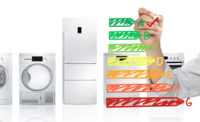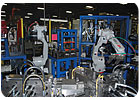
JR Manufacturing Inc. has a simple and effective strategy: Improve efficiency by replacing menial labor with robotic automation. Greater efficiency means increased competitiveness, and that, in turn, leads to growth and the ability to hire more people.
The formula has worked well thus far. A Tier 2 and Tier 3 automotive supplier, we operate plants in Fort Recovery, OH, and Manchester, TN. We produce pillars and welded-wire frames for seats and headrest cushions. Two of our biggest customers are TS Tech North America and Setex Inc., which are the main suppliers of seats for Honda Motor Co.’s North American assembly plants.
Since 2003, when new owners and management took over the company, dozens of robots have moved in to manipulate components in and around automated welding cells. The automation has supported accelerated growth for the company. Our sales have blossomed from $4.4 million in 2003 to $24 million in 2010 and a projected $28 million in 2011.
Founded in 1998, JR Manufacturing began by fabricating seamless metal buckets for citronella candles. Within months of opening our doors, a nearby automotive seat manufacturer came looking for a supplier of formed seat wires, and the rest is history. In less than two years, JR Manufacturing had designed and built its own dedicated pneumatic forming machines to produce formed wire components for Honda seat-cushion and armrest frames.
As our seat-component business grew, the citronella-bucket line was discontinued. Our 40,000-square-foot plant was expanded and a pair of automated headrest lines moved in, capable of forming and welding headrest fames at up to 300 frames per hour.
Seven years later, the plant is now home to 45 robots from the Motoman Robotics Div. of Yaskawa America Inc. Ten robots throughout the plant perform welding operations, either by arc or resistance processes, while 35 robots move material in and around manufacturing cells. These material-handling robots pluck formed wires and headrests from forming machines and place them into weld fixtures. Most of the action occurs in engineered production cells where material-handling robots sit center stage, surrounded by a set of custom, dedicated wire-forming machines.
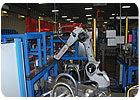
By
arranging a wire-forming and welding cell based on the reach of each robot, JR
Manufacturing minimizes the number of robots needed without affecting cycle time.
This minimizes capital investment and optimizes equipment utilization. Photo
courtesy JR Manufacturing
Process Development
We build almost all of our own tools in-house, as well as a lot of specialized equipment. That gives us the ability to control our processes and achieve extremely tight tolerances. Combined with our advanced automation capabilities, that has allowed us to compete in the world market and complete some very aggressive cost-reduction programs for Honda and its suppliers.Last year, the plant took on eight new car platforms encompassing over 40 new parts. Almost every new program includes headrests, which account for half of our business. Other programs include formed wire components and complete seat frames.
Our move to cellular manufacturing, which began in 2005 and really took off in 2008, was a key factor in enabling us to take on this new business. We manufacture 30 different designs of headrests. Before we reorganized the plant into production cells, we used to task operators with moving baskets of formed tube and wire parts all over the plant, from the forming machines and into a robotic welding cell. All of that material handling was very inefficient.
We’re processing 20,000 pounds of wire and another 20,000 pounds of tubing every day. Implementing cellular manufacturing, using robots for material handling, has paid huge dividends. The strategy has allowed us to reduce our labor costs, and share those cost reductions with our customers.
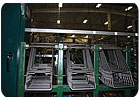
Welded assemblies, such as the rear-seat armrest frames
shown here, leaving the assembly cell are checked 100 percent with an
integrated vision system before being loaded on the “green” rail. Photo
courtesy JR Manufacturing
Project Saves $100,000
A fabrication cell for armrest frames is a good example of how our automation approach lowers costs. We built the cell in 2008. It consists of five custom-made wire-forming machines, a resistance-welding robot, and two robots to move the material around the cell from machine to machine, grabbing formed wire segments and loading them in a weld fixture. Implementing cellular manufacturing for this project saved our customer $80,000 to $100,000 per year, at a volume of 7,500 welded assemblies per week.Moving wire-bending machines into a robotic welding cell is not as simple as it sounds. You have to provide access for the material-handling robot’s end-of-arm tool, so the robot can quickly and accurately locate and grasp the wire and tube sections in the correct orientation.
Before, when we were fabricating parts by the thousands and moving them in small totes to remote welding cells, we could design the bending machines to simply drop formed parts into a pan or onto an exit conveyor for manual handling by several operators.
Now, the bending machines have to work inside of a welding cell. We designed the bending machines with a central clamp that holds the part from beginning to end, so the robot’s gripper can access and grab the part. The process is more efficient, dramatically reduces labor and allows us to reassign laborers to perform more critical functions around the plant. The machine does not release the part until the robot has grabbed it, allowing us to precisely and repeatedly identify and control the orientation of the part so that it can be accurately loaded into the weld fixture. Sensors tell each forming-machine clamp that the robot’s gripper has the part and it’s OK to release it.
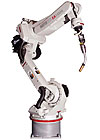
JR Manufacturing’s Ohio
assembly plant hosts 45 robots, such as this six-axis, arc-welding robot. Photo
courtesy JR Motoman Robotics Div. of Yaskawa America Inc.
Tight Tolerances
Seat frames are built of mild-steel wire, while high-strength low-alloy steel tubing is used for headrests. Small-diameter wires (8 millimeters and less) are resistance-welded together into frames, while larger sections of wire or formed tube (up to 14 millimeters in diameter for headrests) are arc-welded. Rear seat-cushion frames average eight to 10 wires each. A typical weld time is 30 seconds, so that’s how much time the material-handling robots have to move around a cell, pick up each formed wire component, and place it into the weld fixture.For the most part, we receive weekly releases from our customers, but occasionally we also get daily releases, which test our manufacturing flexibility. We build inventory and ship on release. Volumes range from 6,000 to 30,000 per week for headrest assemblies and 6,000 to 8,000 per week for frames.
Eighty percent of this work is completed on dedicated, automated production equipment, as opposed to CNC wire and tube benders. This allows us to hold extremely tight tolerances. Our reject rate is less than 10 parts per million, and our on-time delivery rate is 100 percent.
Dimensional tolerances on individual parts are as little as 0.2 millimeter, and tolerances on assemblies are equally stringent. On a 4-foot-wide seat frame built up from several welded wire sections, we hold a dimensional tolerance of 3 millimeters on the completed assembly-quite an accomplishment in light of the tolerance stackup when welding that many parts together into an assembly. Critical to our success is our fixtures, which are designed and built in-house, as well as our custom wire benders. Accurate parts make for predictable and, therefore, accurate weldments.
ASSEMBLY ONLINE
For more information on robotic assembly, visit www.assemblymag.com to read these articles:•Robots Help Assembler Break the Mold.
•Robots Make Victor a Champion.
•Arc Welding With Robots.
